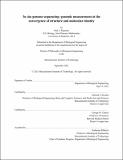In situ genome sequencing: genomic measurement at the convergence of structure and molecular identity
Author(s)
Reginato, Paul L.
DownloadThesis PDF (53.23Mb)
Additional downloads
Advisor
Boyden, Edward S.
Church, George M.
Terms of use
Metadata
Show full item recordAbstract
A central aim of contemporary biology is to understand the function and behavior of molecules in the context of whole individual cells. Progress has been largely driven by two families of measurement technology: microscopy and DNA sequencing. Microscopy directly provides rich information on structure and organization, while sequencing directly provides rich information on the identities of molecular species. Both microscopy and sequencing have developed the resolution needed for molecular characterization of cells: respectively, they can resolve the relative organization and identities of single biomolecules at the scale of an entire single cell. The scientific utility of each is now primarily limited by its inability to recapitulate the measurements of the other: since biomolecules exist in a 3D world and function through spatially local interactions, their diverse identities and relative structural organization within a cell are two sides of one coin. Recent technologies, such as highly multiplexed fluorescent in situ hybridization and in situ RNA sequencing, seek to unify the measurement of structure and biomolecular identity, thus enabling molecular mapping of biological samples.
In this thesis, I report the collaborative development of in situ genome sequencing (IGS), the first technology for simultaneously sequencing and imaging genomes in intact biological samples. We applied IGS to spatially localize thousands of genomic sequences in individual human fibroblasts and early mouse embryos, thereby mapping their genome structure. We went on to develop expansion genome sequencing (ExGS), which integrates IGS with expansion microscopy to achieve ~3.5-fold greater spatial and ~14-fold greater genomic resolution in cultured cells. ExGS indicates a scalable path toward in situ genome sequencing with near-complete genomic resolution. I anticipate that these developments in genomic measurement technology will be instrumental for the convergence of structural organization and molecular identity in biological science.
Date issued
2022-02Department
Massachusetts Institute of Technology. Department of Biological EngineeringPublisher
Massachusetts Institute of Technology